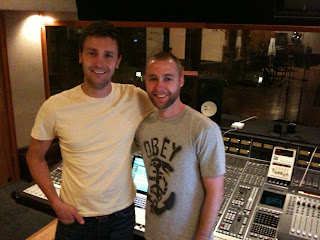Anoushka Shankar recorded her newest album, Traveller, in recording studios around the world but chose Studio West and staff engineer Kellogg Boynton to mix the record! Her sixth full length album focuses on her stellar sitar work and features guest appearances by world renowned players Shubha Mudgal, Concha Buika and Pepe Habichuela. The flamenco inspired album was produced by Grammy Award winner Javier Limon. Traveller is scheduled for an autumn 2011 release on Deutsche Grammophon.
Anoushka and Javier came to Studio West earlier this year to mix the project. Below, Kellogg details some of the highlights from the sessions held in Studio A from January 19th through January 27th:
There were 11 songs total on the album. As far as work flow goes, Javier brought in a drive with all of the Pro Tools sessions recorded at 24/96. I then spread all of the instruments across the SSL and many of the songs had a full 64 faders up. Each song varied in track count but the average was about 80 tracks a song. Some instrument groups were submixed back through the console when it was needed in order to get all the tracks showing up at the desk. Anoushka's sitar mix chain was an API 5500 for EQ, a Manley Vari Mu for compression and a Bricasti M1 for reverb (the best sounding reverb ever in my opinion!) All vocals went through a Tube Tech PE-1C for EQ and an 1176 or Tube Tech CL-1B depending on the vocalist. There was also a bit of subtractive EQ and multiband compression for dynamic frequency control being done in Pro Tools with the Waves RenEQ and the Waves C4. Vocals also saw the Bricasti M1 for reverb. I used the 1272 line amps and the EQ on the BCM-10 for the piano to keep it dark and ominous which was one of their requests. Most of the other instruments saw onboard processing such as EQ and compression from the SSL. Across the mix buss on the SSL I inserted a pair of Pultec EQP-1As for a bit of added low frequency and a Focusrite Red 3 for compression with about 1-3 db of gain reduction for a bit of "sonic glue." It helps bring everything forward in the mix, which I love. As far as plug-ins go, it was pretty minimal. There were a few EQs and comps here and there but mainly what I would reach for were effects that I couldn't get in the analog domain like the Waves RBass. Anoushka really loved what it did to the low end of the tablas and cajon. The output of the console was then recorded through a Burl B2 A/D converter back into Pro Tools at 24/96. I think the input was lowered to around -14 so I could really hit the transformers hard on the way in, adding an extra bit of sonic character to the mix. We averaged mixing about one and a half songs a day. We would finish one in the afternoon, start another one and get it close to being done and come in the next day and finish it, and repeat the process. There were no overdubs during the mixing sessions.
The coolest part of the project was the project itself. Just being asked to mix the record was an honor. The style and genre was definitely different than I usually get here in San Diego, but it was an interesting challenge and I think the project turned out sounding fantastic!
On a side note, Anoushka and I went to the same high school! She was a senior when I was a freshman, but we didn't know each other at the time. Small world!

